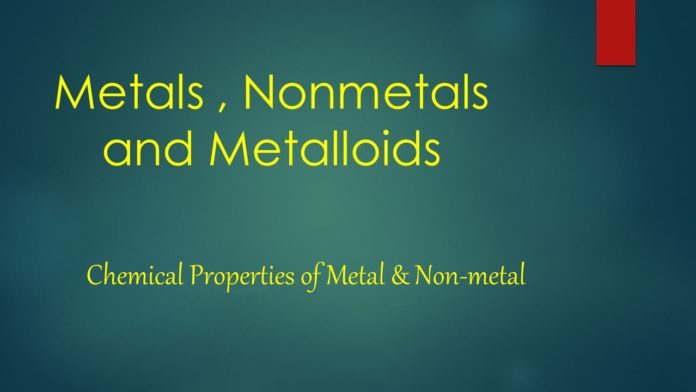Metals and nonmetals are two types of materials that we come with daily. The two elements are metals and nonmetals, and determining whether an element is a metal or a nonmetal is critical.
Metals (such as aluminium and copper) are powerful conductors of heat and electricity, while nonmetals (such as phosphorus and sulphur) are insulators. As shown above, materials are categorised according to their properties.
We will look at what metals and nonmetals are in this article and the physical properties of metals and nonmetals.
What exactly are metals?
The bulk of the elements in the periodic table are metals. This includes alkali metals, transition metals, lanthanides, actinides, and alkaline earth metals. A zigzag line running from carbon to radon separates metals from nonmetals on the periodic table.
Phosphorus, iodine and selenium are the elements that separate the two.

Physical properties of metals
Metals include gold, aluminium, iron, and magnesium, among others. They have the following characteristics:
- Metals may be hammered into thin sheets due to their physical properties. It signifies they can be moulded.
- Metals have a ductile property. Wires can be made out of them.
- Metals are excellent heat and electrical conductors.
- Metals are lustrous, meaning they have a gleaming finish.
- Tensile strength is a property of metals. It indicates they can support a lot of weight.
- Metals have a resonant quality to them. It implies they generate a ringing sound when we strike them.
- Metals are abrasive. It indicates they are difficult to cut.
Chemical Properties of Metals
The following are some chemical characteristics of metals.
- Easy to corrode
- Electrons can be lost.
- Obtain basic oxides
- Electronegativities are poor.
- Reducing effective agents
Metals react with oxygen to generate metallic oxides, which are inherently basic.
Metal + Oxygen ? Metal oxide
Metal oxide + water ? Base
Example – Magnesium is a metal that creates magnesium oxide when it combines with oxygen. Magnesium hydroxide is formed when magnesium oxide is dissolved in water. The following are some of the responses:
2Mg + O2 ? 2MgO
MgO + H2O ? Mg(OH)2
What exactly are non-metals?
Non-metals make up a small percentage of the periodic table. These may be found on the periodic table’s right-hand side. Sulphur, carbon, all halogens, hydrogen, oxygen, phosphorus, selenium, nitrogen, and noble gases are all non-metals.
Non-metal properties have fewer similarities than metal properties. They have a wide range of physical and chemical characteristics. At room temperature, certain non-metals are solids, and others are gaseous.
Nonmetals are these and the elements next to them in the periodic table. Semimetals or metalloids are elements that exist just to the left of the line. These will have qualities that are a mix of metals and nonmetals.
Non-metals occupy the periodic table’s top right-hand section. Non-metals are neither lustrous, malleable, or ductile, nor are they good conductors of electricity, according to their qualities. These non-metal qualities are one way to tell the difference between metals and non-metals.
Non-metals are located in the periodic table to the left of halogens and the right of metalloids. Because they are non-metals, noble gases and halogens are usually referred to as non-metals.
Physical properties of non-metals
- Nonmetals cannot be hammered into thin sheets due to their physical properties. It indicates they don’t have the malleability property. Instead, hammering breaks them down into fragments, making them fragile.
- Nonmetals aren’t ductile in the same way as metals are. They are unable to be formed into wires.
- Heat and electricity conduct poorly through nonmetals.
- Nonmetals aren’t lustrous, meaning they don’t shine. Rather drab in look.
- Tensile strength is low in nonmetals. It implies that they are unable to support big loads.
- Nonmetals aren’t particularly sonorous. It means they don’t make a sound when we strike them.
- Nonmetals are pliable. It suggests they can be readily sliced with a knife.
Non-metal Chemical Properties
The following are some chemical characteristics of non-metals.
- The number of electrons in the outer shell is usually between 4 and 8 in most cases.
- Excellent oxidisers
- When they come into contact with oxygen, they produce acidic oxides.
- Elements with a high electronegative charge
Nonmetals react with oxygen to produce non-metallic oxides, which are acidic.
Nonmetal + Oxygen ? Nonmetal oxide
Nonmetal oxide + water ? Acid
For example, Sulphur is a nonmetal that produces sulphur dioxide when it combines with oxygen. When sulphur dioxide is dissolved in water, sulphurous acid is produced. The following are some of the responses:
S + O2 ? SO2
SO2 + H2O ? H2SO3
Conclusion
Metals and nonmetals are differentiated by their properties. Metals, for example, are malleable, ductile, sonorous, and excellent heat and electricity conductors. Nonmetals are those elements that are not malleable, ductile, sonorous, and have poor heat and electrical conductors.
Metals and non-metals have varying properties (allotropes). They are available in a range of shapes and sizes, as well as different qualities. Elements that exist in more than one physical form are known as allotropes.
Plagiarism Report